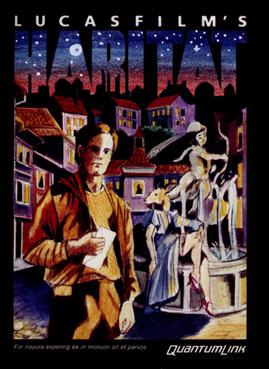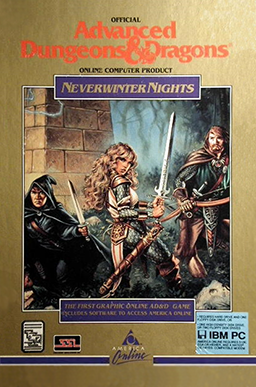This article needs additional citations for verification .(June 2011) |
PlayNet (or PlayNET) was an American online service for Commodore 64 personal computers that operated from 1984 to 1987. It was operated by the PlayNet, Inc of Troy, New York.
This article needs additional citations for verification .(June 2011) |
PlayNet (or PlayNET) was an American online service for Commodore 64 personal computers that operated from 1984 to 1987. It was operated by the PlayNet, Inc of Troy, New York.
PlayNet was founded [1] in 1983 by two former GE Global Research employees, Dave Panzl and Howard Goldberg, [2] as the first person-to-person, online communication and game network to feature home computer based graphics.
The founders launched the business initially with their own money. They then raised over $2.5 million from a variety of investors, including the venture capital funds of the Town of North Greenbush NY, Key Bank, Alan Patricof & Associates, and the New York State Science and Technology Foundation, and a group of individual investors through a limited R&D partnership led by McGinn Smith.
In 1985, PlayNet licensed their system to Control Video Corporation (CVC, later renamed Quantum Computer Services), which in October 1991 changed its name to America Online. [3] The modified version of the PlayNet software (Quantum Link or Q-Link) was ported by Quantum to the PC to create the first version of the AOL software. As recently as 2005, some aspects of the original PlayNet communication protocols still appeared to be used by AOL. [4]
The PlayNet offices were initially located in the J Building on Peoples Avenue in Troy, NY part of the Rensselaer Polytechnic Institute incubator program. It subsequently moved to RPI's Technology Park in North Greenbush NY.
PlayNet declared bankruptcy in March, 1986 [5] and ceased operations in 1988 after Quantum stopped paying royalties. [6]
The service had two membership options: an $8/month service charge plus $2.75/hour connect time charge, or no service charge and $3.75 per hour connection charge. File downloads were charged a flat rate of $0.50 each
The second season of Halt and Catch Fire (TV series) is believed to be based on PlayNet. [7]
PlayNet was originally designed around online interactive games which allowed chatting while playing. PlayNet also featured electronic mail, online chat, bulletin boards, file sharing libraries, online shopping, and instant messaging (using On Line Messages, or OLMs). Games were mostly 'traditional' games and some well-known boardgames. Games were programmed in a mixture of BASIC and assembly language.
Unlike other online systems of the era, PlayNet was highly graphical and required client software, and included error correction in the communication protocols. The server software for PlayNet ran on Stratus fault-tolerant computers and was written in PL/1. AOL continued to use Stratus computers and parts of the PlayNet server software until the late 1990s or later.
Games/features never finished/released:
Connections to PlayNet were made by modems at 300 baud via X.25 providers such as Tymnet and Telenet. In 1985, pricing was $6 per month, with additional fees of $2 per hour, after a one-time membership fee of $30. [8]
The system competed with many other online services like CompuServe and The Source (service), as well as Bulletin board systems (single or multiuser). PlayNet's graphical display was better than many of these competing systems because it used specialized client software with a nonstandard protocol. However, this specialized software and nonstandard protocol limited its market to the Commodore 64.
In 2005, hobbyists managed to reverse engineer the communications protocol and allow people running the QuantumLink software on an emulator or original hardware (via a serial cable) to run a reduced version of the service called Quantum Link Reloaded.
Ahoy! in 1986 called PlayNET "one of the best values around for Commodore users". The reviewer stated that he had found the network's users "to be just about the friendliest group of people around", but criticized the slow disk load times and the network's weekday hours of operation. [9]

AOL is an American web portal and online service provider based in New York City. It is a brand marketed by the current incarnation of Yahoo! Inc.

AIM was an instant messaging and presence computer program created by AOL, which used the proprietary OSCAR instant messaging protocol and the TOC protocol to allow registered users to communicate in real time.

A bulletin board system (BBS), also called a computer bulletin board service (CBBS), is a computer server running software that allows users to connect to the system using a terminal program. Once logged in, the user can perform functions such as uploading and downloading software and data, reading news and bulletins, and exchanging messages with other users through public message boards and sometimes via direct chatting. In the early 1980s, message networks such as FidoNet were developed to provide services such as NetMail, which is similar to internet-based email.
ICQ New is a cross-platform instant messaging (IM) and VoIP client. The name ICQ derives from the English phrase "I Seek You". Originally developed by the Israeli company Mirabilis in 1996, the client was bought by AOL in 1998, and then by Mail.Ru Group in 2010.

Instant messaging (IM) technology is a type of online chat allowing real-time text transmission over the Internet or another computer network. Messages are typically transmitted between two or more parties, when each user inputs text and triggers a transmission to the recipient(s), who are all connected on a common network. It differs from email in that conversations over instant messaging happen in real-time. Most modern IM applications use push technology and also add other features such as emojis, file transfer, chatbots, voice over IP, or video chat capabilities.

CompuServe was an American online service, the first major commercial one in the world – described in 1994 as "the oldest of the Big Three information services ."

Pidgin is a free and open-source multi-platform instant messaging client, based on a library named libpurple that has support for many instant messaging protocols, allowing the user to simultaneously log in to various services from a single application, with a single interface for both popular and obsolete protocols, thus avoiding the hassle of having to deal with a new software for each device and protocol.

Extensible Messaging and Presence Protocol is an open communication protocol designed for instant messaging (IM), presence information, and contact list maintenance. Based on XML, it enables the near-real-time exchange of structured data between two or more network entities. Designed to be extensible, the protocol offers a multitude of applications beyond traditional IM in the broader realm of message-oriented middleware, including signalling for VoIP, video, file transfer, gaming and other uses.
Quantum Link was an American and Canadian online service for the Commodore 64 and 128 personal computers that operated starting November 5, 1985. It was operated by Quantum Computer Services of Vienna, Virginia, which later became America Online.
An online service provider (OSP) can, for example, be an Internet service provider, an email provider, a news provider (press), an entertainment provider, a search engine, an e-commerce site, an online banking site, a health site, an official government site, social media, a wiki, or a Usenet newsgroup.
AppleLink was the name of both Apple Computer's online service for its dealers, third-party developers, and users, and the client software used to access it. Prior to the commercialization of the Internet, AppleLink was a popular service for Mac and Apple IIGS users. The service was offered from about 1986 to 1994 to various groups, before being superseded by their short-lived eWorld and finally today's multiple Apple websites.
Shoutcast is a service for streaming media over the Internet to media players, using its own cross-platform proprietary software. It allows digital audio content, primarily in MP3 or High-Efficiency Advanced Audio Coding format. The most common use of Shoutcast is for creating or listening to Internet audio broadcasts; however, there are also video streams. The software is available to use for free or as a paid cloud service with additional professional features.
IPX/SPX stands for Internetwork Packet Exchange/Sequenced Packet Exchange. IPX and SPX are networking protocols used initially on networks using the Novell NetWare operating systems. They also became widely used on networks deploying Microsoft Windows LANS, as they replaced NetWare LANS, but are no longer widely used. IPX/SPX was also widely used prior to and up to Windows XP, which supported the protocols, while later Windows versions do not, and TCP/IP took over for networking.

eWorld was an online service operated by Apple Inc. between June 1994 and March 1996. The services included email, news, software installs and a bulletin board system. Users of eWorld were often referred to as "ePeople."

In computing, a client is a piece of computer hardware or software that accesses a service made available by a server as part of the client–server model of computer networks. The server is often on another computer system, in which case the client accesses the service by way of a network.

Habitat is a massively multiplayer online role-playing game (MMORPG) developed by LucasArts. It is the first attempt at a large-scale commercial virtual community that was graphic based. Initially created in 1985 by Randy Farmer, Chip Morningstar, Aric Wilmunder and Janet Hunter the game was made available as a beta test in 1986 by Quantum Link, an online service for the Commodore 64 computer and the corporate progenitor to AOL. Both Farmer and Morningstar were given a First Penguin Award at the 2001 Game Developers Choice Awards for their innovative work on Habitat. As a graphical MUD it is considered a forerunner of modern MMORPGs unlike other online communities of the time. Habitat had a GUI and large user base of consumer-oriented users, and those elements in particular have made Habitat a much-cited project and acknowledged benchmark for the design of today's online communities that incorporate accelerated 3D computer graphics and immersive elements into their environments.
Amiga software is computer software engineered to run on the Amiga personal computer. Amiga software covers many applications, including productivity, digital art, games, commercial, freeware and hobbyist products. The market was active in the late 1980s and early 1990s but then dwindled. Most Amiga products were originally created directly for the Amiga computer, and were not ported from other platforms.

Neverwinter Nights was an early multiplayer online role-playing game to display graphics, and ran from 1991 to 1997 on AOL.
Online games are video games played over a computer network. The evolution of these games parallels the evolution of computers and computer networking, with new technologies improving the essential functionality needed for playing video games on a remote server. Many video games have an online component, allowing players to play against or cooperatively with players across a network around the world.
InterCon Systems Corporation was founded in April 1988 by Kurt D. Baumann and Mikki Barry to produce software to connect Macintosh computers in environments that were not Macintosh-exclusive. At the time, there was no real concept of the Internet and there was still a question of whether the TCP/IP protocols or OSI protocols would be adopted widely. Over the next 9 years, the company grew from three employees to over 100 and sold software in the US, Europe and Japan.